You really don’t need a backyard to raise your own fruit and vegetable garden; a variety of styles and designs will do, and work fine for just about anything you could desire to grow. Just be sure that your pots have sufficient depth to accommodate the plants that you would like to grow.
Here’s a question I received from a gardener wanting to grow fruit and vegetable garden in a New York City apartment:
Hi Kenny, I love your garden! My name is Nicole and I live in a apartment in NYC and would like to know what fruits and vegetables I can grow in my window box (I have 3 window boxes)? Also can you grow tomatoes and train them to grow horizontal, and what herbs are small to group together? Thanks!
 Almost anything that you would typically raise in the ground, can be cultivated just as easily in window boxes, containers, or grow bags . Even though I know how to plant a raised bed garden, I still make use of pots for additional plants and fruit trees that are raised on the deck and patio.
Almost anything that you would typically raise in the ground, can be cultivated just as easily in window boxes, containers, or grow bags . Even though I know how to plant a raised bed garden, I still make use of pots for additional plants and fruit trees that are raised on the deck and patio.
Here is the write up of a garden design that I submitted as part of a Bonnie Plants contest held amongst the bloggers at this year’s Garden 2 Blog event. It can provide an example of some combinations and techniques to use in planning your own container garden. The design contest utilized three containers; one 24 inch, one 18 inch, and one 14 inches in size.
A Three Course Gourmet Salad, Container Garden
Plant this sample container garden and enjoy fresh gourmet salads all summer from a mix of 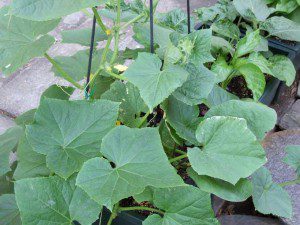 succulent veggies, tender leafy greens, and fresh herbs. Each pot is designed to utilize vertical space, maximize production within the container, and take advantage of a cascading plant to expand the growing area even further. This gourmet container garden combines colorful and nutritious salad ingredients that you can easily grow, just about anywhere.
succulent veggies, tender leafy greens, and fresh herbs. Each pot is designed to utilize vertical space, maximize production within the container, and take advantage of a cascading plant to expand the growing area even further. This gourmet container garden combines colorful and nutritious salad ingredients that you can easily grow, just about anywhere.
1). Slicing Vegetables (24” Container)
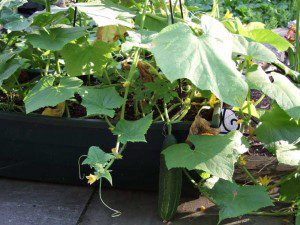 Sungold Tomato – A great tasting cherry tomato suitable for container growth, but productive enough to supply fruits over an extended period. Trellis the plant and pinch excess suckers to maintain support and utilize your vertical growing space.
Sungold Tomato – A great tasting cherry tomato suitable for container growth, but productive enough to supply fruits over an extended period. Trellis the plant and pinch excess suckers to maintain support and utilize your vertical growing space.
Gypsy Pepper – Want to grow peppers in an assortment of colors but find yourself with limited room? This variety might be the solution; it ripens from light yellow, to orange, and finally red, offering multiple color options of sweet peppers from a single plant.
Lemon Cucumber – This productive heirloom variety will produce small, round, yellow cucumbers. Let the vines ramble over the edge of the container and trail along the outside of the pot to make the most of the growing space that containers provide.
2). Leafy Greens (18” Container)
Swiss Chard – Here’s a productive leafy green vegetable that is great when eaten either cooked or raw. This is the tallest member of 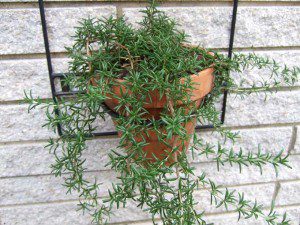 this group, so plant it towards the rear of the container where it won’t over power its shorter growing companions.
this group, so plant it towards the rear of the container where it won’t over power its shorter growing companions.
City Garden Lettuce Mix – A blend of leaf colors, sizes, and shapes makes this a great lettuce for the container garden. You can cut it down and allow the plants to “come again” or harvest individual leaves for continuous production over an extended period.
Nasturtiums – Both the leaves and colorful flowers are completely edible and will decorate your garden as well as the salad bowl! Let this one trail and grow over the side of the container to maximize space usage in your gourmet salad container garden.
3). Fresh Herbs (14” Container)
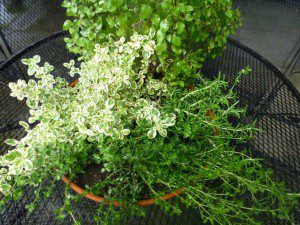 Purple Basil – A tall, upright growing herb, basil will take advantage of the vertical growing zone in your herb container. Use it sparingly in salads or with a heavy hand in your favorite “purple” pesto recipes.
Purple Basil – A tall, upright growing herb, basil will take advantage of the vertical growing zone in your herb container. Use it sparingly in salads or with a heavy hand in your favorite “purple” pesto recipes.
Lemon Thyme – This compact herb makes a great addition to any garden. The tiny fresh leaves can be stripped from the stems right onto the top of your favorite salad or other gourmet dishes.
Rosemary – An ornamental herb that will find many practical uses around the kitchen. Select a low-growing, creeping variety for the container garden and plant it close to the container’s edge so it will sprawl over the side to help conserve space for the other herbs.
That’s it, the rule of 3 dominates in this sample gourmet container garden that I laid out; with three containers each featuring different edible plant types, three plant 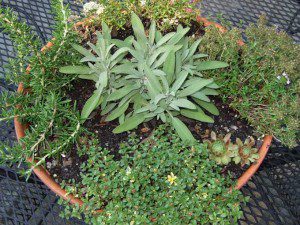 varieties per container, and three separate growing zones being utilized by each group of plants.
varieties per container, and three separate growing zones being utilized by each group of plants.
There are endless combinations of plants that can be grouped together to fashion incredible food gardens regardless of how much space you have to work with.



16 Responses
This is very informative. I would also like to grow plants in a container since I don’t have a wide space for gardening. Thanks for sharing! 😉
Absolutely there are so many vegetables and herbs which we can grow in general pot. It will look beautiful and simultaneously it is easy for us to take care of them.
Great post! Love sungold cherry tomatoes – absolutely my favorite. Currently living on a farm so don’t really have the need to use grow boxes but I am planning on making an online mini garden course for growing in small spaces. Great information here! 🙂
Hi
I’ve been wondering is it better to use a container or some veggie-bed (whatever these are called.)
These are great ideas! I live in an apartment so this is great!
Love that i came across this 5×5 setup. its quite compact and lots of food coming from it. although i would love to build one of these, I’m starting a container garden using all my hubby’s leftover gallon milk jugs. He sure does love his milk. We go through a gallon or two each week so I have lots of veggie plants that I can get started
It’s really fun to grow vegetables in garden containers. It’s so satisfying once you harvest those vegetables. My favorites are Sungold Tomatoes and lemon cucumbers. 😀
Cleaning your private home on a normal foundation will
be very lots critical. It ensures a higher similarly to a wholesome living
environment. however From my enjoy the maximum difficult regions for cleaning
are the steps. it’s far regularly lots overlooked too. however along aspect the
rest of the areas it have to be wiped smooth too and make it unfastened from
dirt and dust. for this reason you want to search for the first rate vacuum for
stairs which could supply the splendid result for cleaning the stairs
correctly. You can find more about it here Best vacuum for
stairs
Great information! It is nice to plant the veggies in the container for well maintenance and for longer use. Now a days, there are so many innovative containers to plant the veggies the garden. http://www.allplanters.com/ is one of them. Here, you will find so many types of decorative planters.
Great information! It is nice to plant the veggies in the container for well maintenance and for longer use. Now a days, there are so many innovative containers to plant the veggies the garden. http://www.allplanters.com/ is one of them. Here, you will find so many types of decorative planters.
I like the idea of grouping the plants together in threes. I’ve just been putting one set of plants per container up till now. I can think of several other combinations of vegetables and herbs that can be used in this way.
-Eric Ackley | theZone9Gardener.com
I like the idea of grouping the plants together in threes. I’ve just been putting one set of plants per container up till now. I can think of several other combinations of vegetables and herbs that can be used in this way.
-Eric Ackley | theZone9Gardener.com
Amazing!! now anyone can grow vegetables in containers, it look good and more clean..
Amazing!! now anyone can grow vegetables in containers, it look good and more clean..
Great article! This is so useful for those of us with small yards. We even wrote about bucket gardening as well! Keep up the great work Kenny! 🙂